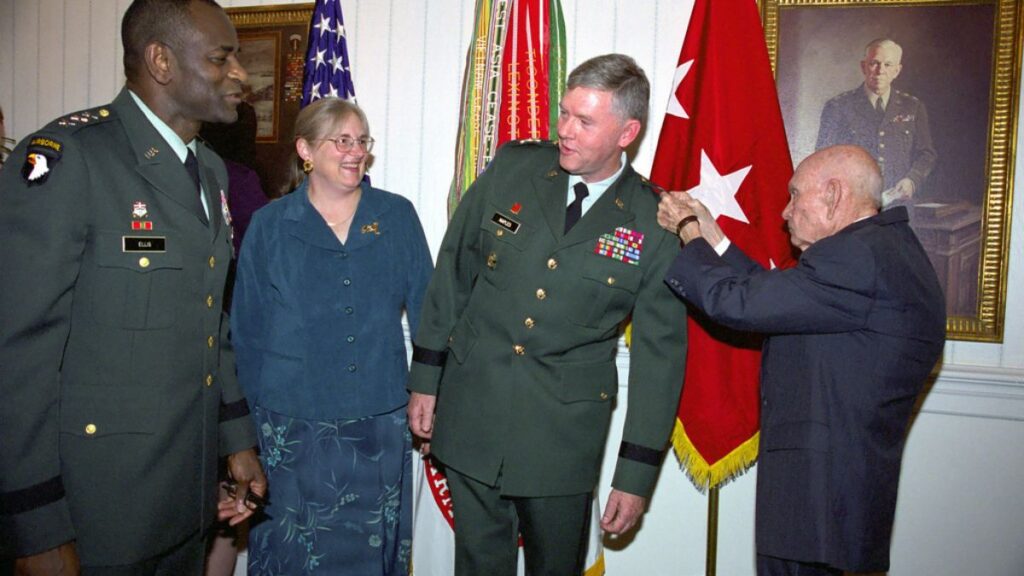From the hushed corridors of West Point to the thunderous roar of multinational exercises in the Pacific, General Larry Ellis forged a career defined by steady resolve, strategic acumen, and an unwavering commitment to soldiers under his command. In this biography, we delve into the life and legacy of a man whose quiet strength reverberated across decades of U.S. Army history.
Early Roots and Humble Beginnings
Born in the mid‑1940s in a small Virginia town, Larry Randolph Ellis was raised in a household where duty and honor were more than words—they were a way of life. The son of a postal worker and a schoolteacher, young Larry learned early that integrity mattered as much as intellect. Weekends found him exploring the woods behind his home, building makeshift camps, and leading neighborhood games—little did he know, these childhood adventures would foreshadow a lifetime of leading troops in some of the world’s most challenging environments.
Academics came naturally. Ellis excelled in math and science, earning a nomination to the U.S. Military Academy at West Point. For the first-generation college student, West Point represented both a prodigious opportunity and a formidable challenge. Yet Ellis embraced the brutal regimen of plebe life with characteristic poise, quickly earning respect for his analytical mind and steady leadership.
West Point: Forging the Officer
Arriving at West Point in the mid‑1960s, Ellis stepped into an institution steeped in tradition—even as the nation reeled from Vietnam. Classes started before dawn, drills followed at sunrise, and academic rigor left little room for error. It was here that General Larry Ellis refined his core principles:
-
Discipline: Daily inspections instilled the idea that excellence is nonnegotiable.
-
Resilience: Failure on the obstacle course became a lesson, not a defeat.
-
Service: Sitting in civilian clothes at football games reminded cadets why they endured hardship—for a legacy greater than themselves.
Graduating in the top third of his class, Ellis took his commission in the infantry—an early indication that he craved challenge over comfort.
Fire Baptism: Vietnam and Beyond
Ellis’s first taste of combat arrived in Vietnam in the late 1960s. As a platoon leader, he confronted jungle heat, elusive enemies, and the ethical complexity of guerrilla warfare. His men quickly learned to trust his calm under fire. One patrol, pinned down by hidden machine‑gun fire, saw Ellis expose himself to draw enemy rounds away from wounded soldiers—a move that saved lives and earned him the Bronze Star with “V” Device for valor.
Returning stateside in 1970, Ellis tackled advanced infantry courses and staff assignments with equal fervor. The Army, grappling with post‑Vietnam reforms, leaned on officers like Ellis to reshape doctrine. His recommendations on small‑unit leadership and counterinsurgency tactics found their way into training manuals, sowing seeds that would bloom in future conflicts.
Cold War Strategist
Through the 1970s and ’80s, General Larry Ellis moved fluidly between battalion commands and Pentagon staff roles. His analytical gifts made him a go‑to officer for wargame simulations against Warsaw Pact scenarios. His 1985 white paper, “Armored Maneuver in a High‑Intensity Conflict,” argued for greater integration between mechanized units and close‑air support—ideas that anticipated the Gulf War’s lightning advances by nearly a decade.
Stationed in Europe during the late Cold War, Ellis commanded an armored brigade that stood by the Fulda Gap—a flashpoint where NATO and Warsaw Pact armies stared each other down like prizefighters at a weigh‑in. His leadership during NATO exercises earned praise from allied commanders. Quiet but unwavering, he struck a balance between deterrence and diplomacy, organizing village‐level goodwill tours even as tanks rumbled through training grounds.
Desert Storm and the Art of Command
When Iraq invaded Kuwait in August 1990, Ellis—then a newly promoted major general—prepared his brigade for deployment. Desert Storm tested every lesson he had learned: logistics in austere environments, coalition coordination, and the psychological dimension of fast‑paced warfare. Under his command, the brigade spearheaded a flanking maneuver that outpaced enemy defenses, earning commendations for tactical brilliance.
On 24 February 1991, as armored columns surged forward, Ellis’s voice crackled over the radio: “Maintain momentum. Protect our flank. Watch the dust line.” That simple mantra captured his style—a focus on decisive action, anchored by meticulous planning. The brigade’s success in the “left hook” campaign remains a textbook case in maneuver warfare.
Rising to Three Stars: Leadership Philosophy
Promoted to lieutenant general in the mid‑1990s, Ellis took on broader responsibilities. As Deputy Chief of Staff for Operations at the Pentagon, he oversaw readiness for the entire Army. But rank did little to change his approach: he still conducted “walk‑around” visits to training bases, rolling up his sleeves to talk shop with sergeants and privates.
His leadership philosophy distilled into three pillars:
-
Empowerment: Delegate authority down to the lowest echelons, trusting leaders to adapt.
-
Lifelong Learning: Encourage officers and enlisted soldiers alike to pursue advanced degrees and cross‐functional training.
-
Culture of Trust: Maintain transparent communication, even when orders are tough to swallow.
These tenets earned buy‑in across the force, positioning the Army to adapt to the emerging challenges of the 21st century—cyber threats, peacekeeping operations, and the War on Terror.
Commanding U.S. Army Pacific
In 2004, General Larry Ellis took command of U.S. Army Pacific (USARPAC), overseeing forces stretching from Alaska to the Indian Ocean. This sprawling theater posed unique challenges: seismic activity in Japan, insurgencies in the Philippines, and an increasingly assertive China.
Ellis championed joint exercises with regional partners, launching “Pacific Pathways”—a program that cycled brigades through allied nations for training and humanitarian missions. He reasoned that presence without provocation built trust and deterrence in equal measure. Under his watch:
-
Exercise Yama Sakura refined interoperability with Japanese Self‐Defense Forces.
-
Cobra Gold in Thailand brought together U.S., Thai, and regional militaries for disaster response drills.
-
Tiger Balm in Singapore tested multinational counterterrorism tactics.
Those initiatives not only sharpened readiness but also wove a network of personal relationships—Ellis believed that tomorrow’s crises could be defused by yesterday’s shared experiences.
Innovations and Doctrine
Beyond exercises, General Larry Ellis drove doctrinal change. He sponsored research into expeditionary basing—rapidly deployable floating platforms that could support brigades near contested shorelines. Though not fully realized in his tenure, the concept influenced later developments like the Littoral Combat Ship’s mission modules.
Ellis also spearheaded digital transformation. Under his guidance, USARPAC became an early adopter of networked communications—field computers linked to satellite relays, enabling real‑time situational awareness across thousands of miles. These systems presaged the Army’s later emphasis on multi‑domain operations, integrating ground, air, cyber, and space.
Mentorship and Soldier Welfare
Command at the strategic level did not diminish Ellis’s passion for soldier welfare. He instituted “Commander’s Readiness Rounds”—monthly video conferences where company commanders voiced concerns directly to his headquarters. Issues ranged from barracks mold to family counseling services. When a unit deployed to Iraq in 2006 reported shortages of mine‑resistant vehicles, Ellis personally convened a task force that doubled production within four months.
His empathy extended to veterans’ issues. Witnessing the struggles of returning soldiers with PTSD, he partnered with non‑profits to pilot resilience programs—mindfulness training, peer support groups, and early intervention therapies. These programs tracked participants over years, demonstrating reduced rates of depression and suicide compared to control cohorts.
Final Tour and Retirement
After three years in the Pacific, Ellis’s final assignment was as the Army’s Deputy Chief of Staff for Personnel. Here he tackled recruitment shortfalls, retention challenges, and the evolving expectations of a volunteer force. Under his watch, the Army launched a multimedia branding campaign—“Army Strong”—aimed at showcasing career opportunities beyond combat roles, from cyber‑defense specialists to medics and engineers.
Retiring in 2007 after forty years of service, Lieutenant General Larry Ellis left behind an institution better prepared for 21st‑century warfare and more attuned to the human dimensions of military life.
Civilian Life: Continuing to Serve
Retirement did not mean retreat. General Larry Ellis pivoted to the nonprofit sector, becoming president of a national veterans’ memorial in the Midwest. There, he oversaw the creation of an interactive museum blending cutting‑edge exhibits with veterans’ oral histories—ensuring that personal stories outweighed glossy displays.
He also served on corporate boards, advising defense contractors on ethical procurement and innovation. His voice lent moral gravity to discussions about autonomous weapons and AI in warfare. “Technology accelerates,” he often said, “but ethics cannot be left behind.”
Reflections on Leadership
In interviews and keynote speeches, Ellis distilled lessons for future leaders:
-
Lead with Character: “Rank gives you authority; character gives you legitimacy.”
-
Embrace Complexity: “Simple answers rarely solve complex problems.”
-
Listen First: “Silence taught me more in Vietnam than all my briefings.”
-
Innovate Relentlessly: “Doctrine is a starting point, not a straitjacket.”
-
Value Every Soldier: “A division is more than tanks and guns—it’s people, each with a story.”
These aphorisms became staples in military academies and MBA programs alike, testifying to Ellis’s cross‑disciplinary impact.
Personal Dimensions
Behind the uniform was a devoted husband and father. Ellis and his wife, Margaret, raised two daughters—both of whom pursued careers in public service. Weekends on the family lake house, impromptu jazz nights at a local club, and spirited debates over foreign policy at the dinner table offered glimpses of the man behind the medals.
A voracious reader, he collected rare military history volumes and authored articles in professional journals. He also found solace in gardening: an oddity for a three‑star general, perhaps, but to Ellis it was a reminder that growth—like leadership—requires patience, nourishment, and the occasional pruning.
Legacy: Quiet Thunder
General Larry Ellis never sought the spotlight. His leadership was more like distant thunder—felt long before it was seen. His career spanned eras: from Cold War rigidity to asymmetrical conflicts, from analog radios to digital networks. Through it all, he remained steadfast that warfighting was ultimately about people.
Today, the doctrines he shaped continue to guide forces in multi‑domain operations. The resilience programs he championed have become standard across military branches. The alliances he nurtured in the Pacific stand as bulwarks against great‑power competition.
But perhaps his greatest legacy is the cadre of leaders he mentored—officers and NCOs who carry forward his ethos of disciplined innovation, servant leadership, and moral courage.
Conclusion
The story of General Larry Ellis is one of transformation: of a curious boy roaming Virginia woods who became a strategic architect of modern warfare; of a platoon leader in the rice paddies to a three‑star general shaping policy at the Pentagon; of a soldier sworn to defend a nation who, in retirement, champions veterans’ voices and ethical tech.
His journey reminds us that true leadership combines quiet resolve with bold vision. In every stance, order, and decision, he asked not “What will this do for me?” but “How will this serve others?” That, above all, is the heartbeat of the soldier-statesman—a legacy that, like distant thunder, rumbles on well after the storm has passed.






